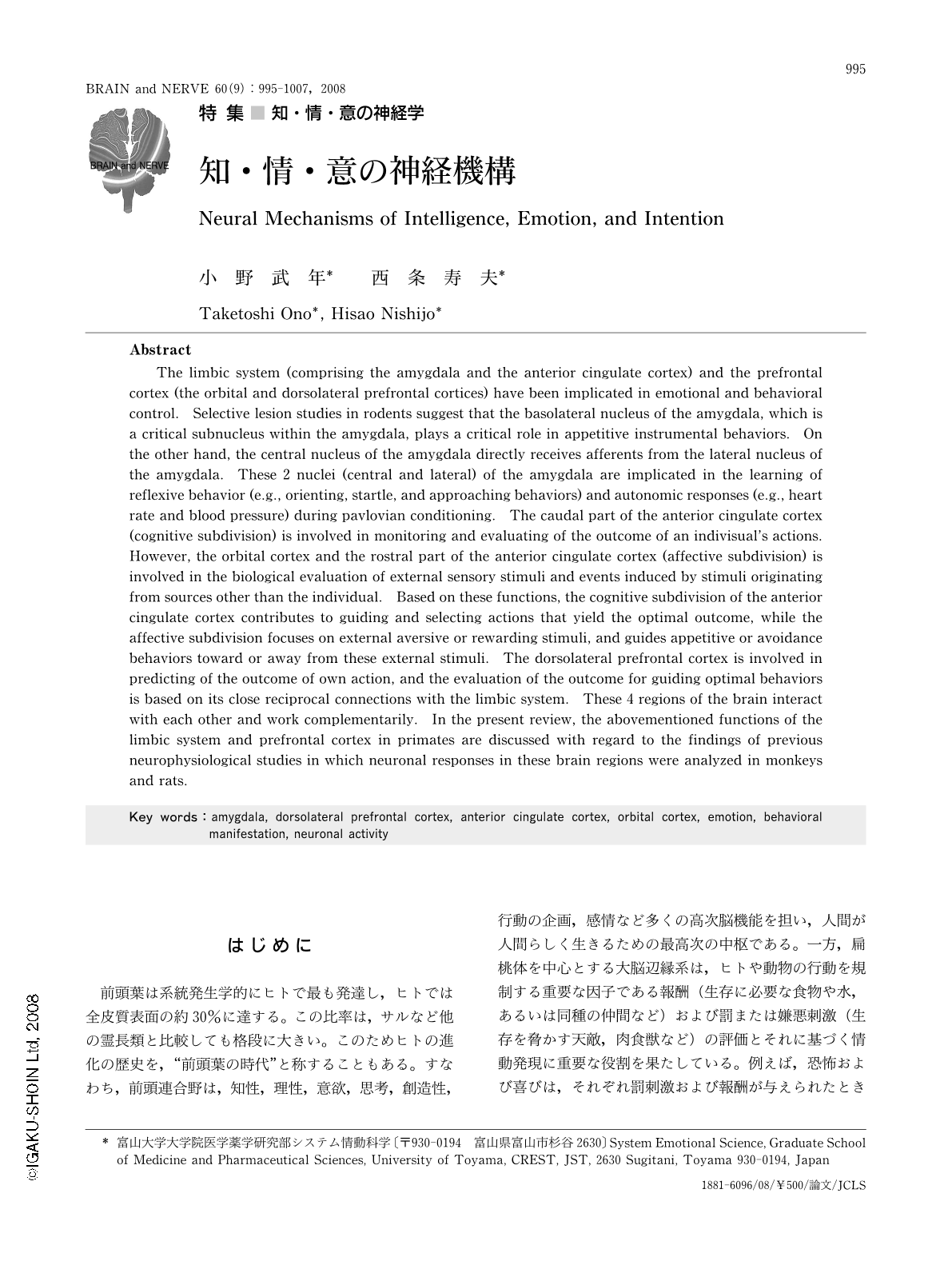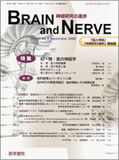Japanese
English
- 有料閲覧
- Abstract 文献概要
- 1ページ目 Look Inside
- 参考文献 Reference
はじめに
前頭葉は系統発生学的にヒトで最も発達し,ヒトでは全皮質表面の約30%に達する。この比率は,サルなど他の霊長類と比較しても格段に大きい。このためヒトの進化の歴史を,“前頭葉の時代”と称することもある。すなわち,前頭連合野は,知性,理性,意欲,思考,創造性,行動の企画,感情など多くの高次脳機能を担い,人間が人間らしく生きるための最高次の中枢である。一方,扁桃体を中心とする大脳辺縁系は,ヒトや動物の行動を規制する重要な因子である報酬(生存に必要な食物や水,あるいは同種の仲間など)および罰または嫌悪刺激(生存を脅かす天敵,肉食獣など)の評価とそれに基づく情動発現に重要な役割を果たしている。例えば,恐怖および喜びは,それぞれ罰刺激および報酬が与えられたときの精神身体的反応であり,怒りおよび安心感は,予定されていたそれぞれ報酬および罰刺激が省略あるいは中途中止されたときの精神身体的反応である1)。これらの情動がモチベーションとなり,動物は生存するために,報酬およびそれを予告する刺激は追い求め(喜びなどの快情動に基づく接近行動),罰およびそれを予告する刺激は避けようとする(恐怖などの不快情動に基づく回避あるいは逃避行動)。近年の研究により,前頭前野(背外側前頭前野,眼窩皮質)と大脳辺縁系(扁桃体,前部帯状回)は相互に密接な線維連絡を有し,ヒトが合目的行動戦略を決定する際には,これら大脳辺縁系とともに前頭前野が1つのシステムとして機能していることが明らかにされつつある。本稿では筆者らの研究を中心に,これら領域の機能的役割に関して最近の知見を概説したい。
Abstract
The limbic system (comprising the amygdala and the anterior cingulate cortex) and the prefrontal cortex (the orbital and dorsolateral prefrontal cortices) have been implicated in emotional and behavioral control. Selective lesion studies in rodents suggest that the basolateral nucleus of the amygdala, which is a critical subnucleus within the amygdala, plays a critical role in appetitive instrumental behaviors. On the other hand, the central nucleus of the amygdala directly receives afferents from the lateral nucleus of the amygdala. These 2 nuclei (central and lateral) of the amygdala are implicated in the learning of reflexive behavior (e.g., orienting, startle, and approaching behaviors) and autonomic responses (e.g., heart rate and blood pressure) during pavlovian conditioning. The caudal part of the anterior cingulate cortex (cognitive subdivision) is involved in monitoring and evaluating of the outcome of an indivisual's actions. However, the orbital cortex and the rostral part of the anterior cingulate cortex (affective subdivision) is involved in the biological evaluation of external sensory stimuli and events induced by stimuli originating from sources other than the individual. Based on these functions, the cognitive subdivision of the anterior cingulate cortex contributes to guiding and selecting actions that yield the optimal outcome, while the affective subdivision focuses on external aversive or rewarding stimuli, and guides appetitive or avoidance behaviors toward or away from these external stimuli. The dorsolateral prefrontal cortex is involved in predicting of the outcome of own action, and the evaluation of the outcome for guiding optimal behaviors is based on its close reciprocal connections with the limbic system. These 4 regions of the brain interact with each other and work complementarily. In the present review, the abovementioned functions of the limbic system and prefrontal cortex in primates are discussed with regard to the findings of previous neurophysiological studies in which neuronal responses in these brain regions were analyzed in monkeys and rats.

Copyright © 2008, Igaku-Shoin Ltd. All rights reserved.


